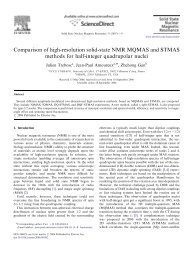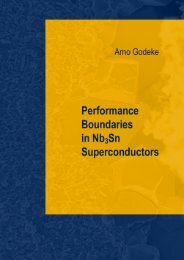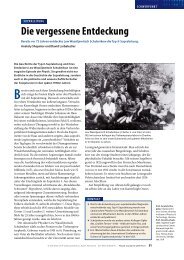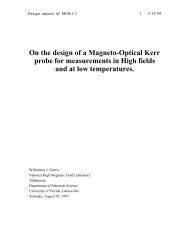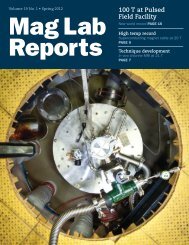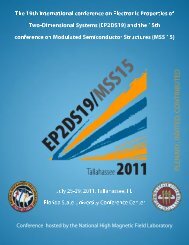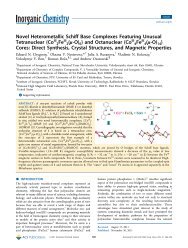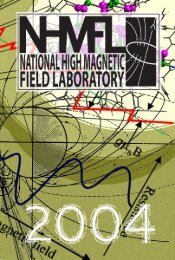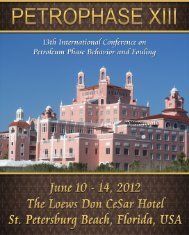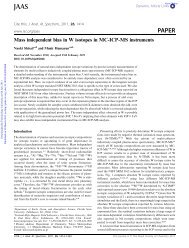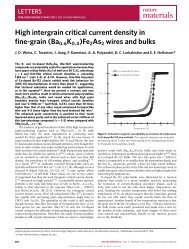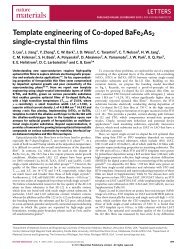Microscopes and Crystals - National High Magnetic Field Laboratory
Microscopes and Crystals - National High Magnetic Field Laboratory
Microscopes and Crystals - National High Magnetic Field Laboratory
You also want an ePaper? Increase the reach of your titles
YUMPU automatically turns print PDFs into web optimized ePapers that Google loves.
ACTIVITY 13: EXPLORING MICROSCOPES<br />
m6: <strong>Microscopes</strong> <strong>and</strong> <strong>Crystals</strong><br />
Reading. Read aloud (or have available) A Drop of Water by Walter Wick (ISBN 0-590-22197-3).<br />
This book uses illustrations <strong>and</strong> some text to describe the properties of a drop of water. This<br />
relates directly to the first Exploration in Activity 13, making a water drop magnifier.<br />
Reading. The book, Looking for Atlantis by Colin Thompson (ISBN 0-679-85648-X) is rich<br />
with images that challenge the reader to identify the thous<strong>and</strong>s of objects “hidden” in the pictures.<br />
Beneath each illustration is another illustration of an imaginary world. Have students use their<br />
powers of observation to identify as many items as they can <strong>and</strong> then compare with classmates<br />
to develop a complete list.<br />
HISTORICAL VIGNETTE: ZACHARIAS JANSSEN<br />
The origin of the optical microscope is a matter of debate. However, most scholars agree that<br />
the invention of the compound microscope can be credited to Zacharias Janssen in the late<br />
sixteenth century. At that time eyeglasses were beginning to enjoy widespread use <strong>and</strong> this<br />
focused a great deal of attention on optics <strong>and</strong> lenses. This first microscope was made in the<br />
year 1595 probably with the help of his father Hans Janssen. Part of the confusion about who<br />
actually invented the first compound microscope is due to the fact that no early Janssen<br />
microscope has survived. A microscope that can be found in a Middleburg, Holl<strong>and</strong>, museum<br />
is reported to be an early Janssen-made microscope.<br />
Luckily, there was one true Janssen microscope that survived long enough to be studied. As<br />
was customary at the time, the Janssens made several examples of their microscope to give to<br />
royalty. One of those was sent to Prince Maurice of Orange, <strong>and</strong> one was given to Archduke<br />
Albert of Austria. Neither of these microscopes survived to modern times, but in the early<br />
1600’s a childhood friend of Zacharias Janssen examined it <strong>and</strong> recorded his observations. He<br />
described the royal instrument as being made of three sliding tubes, measuring 18 inches long<br />
when fully extended, <strong>and</strong> two inches in diameter. It was very ornate, with 3 brass dolphins at<br />
the end forming the feet of a tripod. This early microscope was different from modern<br />
microscopes in that it only contained 2 lenses, <strong>and</strong> magnified objects nine times.<br />
After the invention of this microscope, many other scientists began to experiment with ways of<br />
improving this early microscope. Most of them made improvements by grinding the lenses<br />
more carefully, <strong>and</strong> by having more than two lenses to magnify objects.<br />
Activity. Robert Hooke was the first scientist to use the term cell for the individual units of<br />
living things. Encourage students to research how Hooke decided on this name, <strong>and</strong> to draw<br />
what he first saw.<br />
Writing. The only way that we know that Zacharias Janssen invented an improved microscope<br />
was because someone else documented his invention. Discuss with students the importance of<br />
keeping accurate <strong>and</strong> detailed records in both words <strong>and</strong> drawings. Use the field microscope<br />
from your package <strong>and</strong> have students draw the instrument <strong>and</strong> write a description of how it<br />
SCIENCE, OPTICS & YOU GUIDEBOOK<br />
- 123 -



